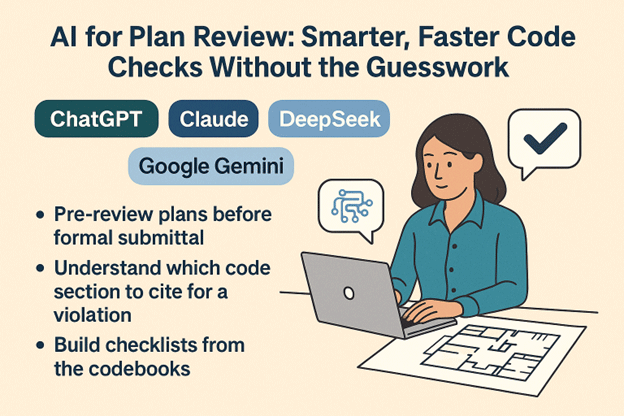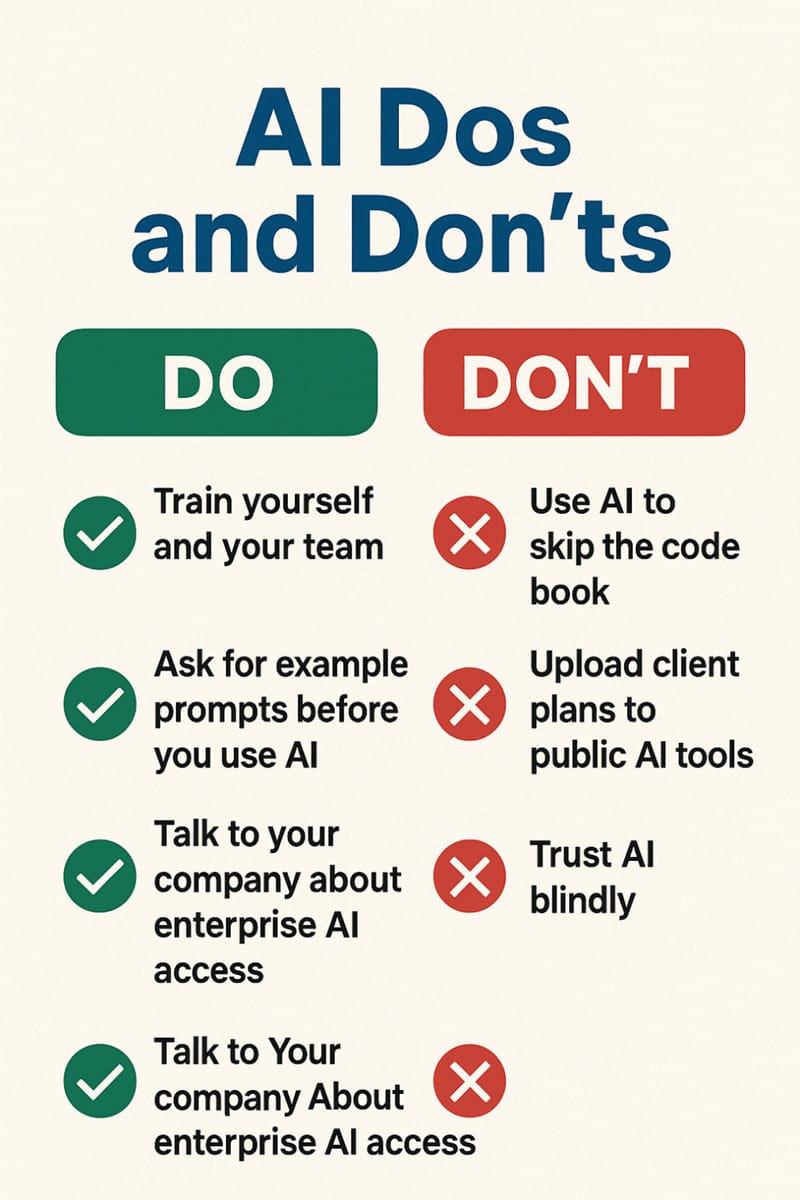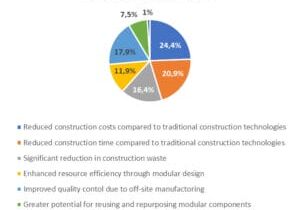AI for Plan Review
Smarter, Faster Code Checks Without the Guesswork

Rahul Bajaj, PE, MCP, is the Associate Director of Modular Plan Review, Central Region, at PFS TECO.
Everyone’s Talking About AI — Here’s What It Can Really Do for Plan Reviewers
You’ve probably heard the buzz — AI is everywhere. Tools like ChatGPT, Claude, DeepSeek, and Google Gemini are being used for everything from writing emails to passing law exams. It seems like everyone is jumping on the AI train. But what can these tools really do for professionals in modular construction and plan review? Let’s break down how AI can be a powerful assistant — cutting down hours of code research, helping you prep for certification exams, and even expanding your understanding of the codes you work with every day.
AI: What It Is and Why It Matters
AI tools like ChatGPT and Claude are examples of what’s called “large language models” (LLMs). In simple terms, they’re trained on a massive amount of text from books, websites, and documents. They use this information to answer questions, summarize documents, and help generate ideas. Think of them as supercharged search engines that can talk back. The more specific your question, the more useful and relevant the answer can be.
How AI Helps with Code Compliance
Let’s say you come across something unfamiliar in a plan — this morning, for example, I reviewed a building with optional solar panels. I didn’t know which NEC sections applied off the top of my head. Rather than digging through the entire NEC table of contents, I asked AI:
Example prompt: “Which NEC 2020 sections apply to solar panel installation on modular buildings?”
Within seconds, it pointed me toward relevant sections like Article 690 (Solar Photovoltaic Systems) AI for Plan Review and gave me key concepts to look out for. I still reviewed the codebook myself — but AI saved me 30-60 minutes by showing me where to start.
AI Dos and Don’ts
Do: Use AI to Train Yourself and Your Team
Preparing for code certification exams? AI can quiz you.
Example prompt: “Write 120 multiple choice questions with answers based on 2021 IBC for the ICC Building Plans Examiner test. Make it a 2-hour exam format.”
You can use similar prompts for the IAPMO tests or state-specific exams like Wisconsin’s UDC Certification. You can even fine-tune the difficulty: “Make half the questions easy, a quarter medium, and a quarter hard.”
Don’t: Use AI to Skip the Code Book
AI is not a replacement for reading the code. It can be a shortcut to knowing what part of the code to read. If you’re citing something in your review comment or correction notice, verify it against the actual code language.
Do: Ask for Example Prompts Before You Use AI
Try these prompts:
- “What are the egress requirements for a modular dorm building under 2021 IBC?”
- “Give me a summary of key IECC 2015 requirements for factory-built buildings.”
- “How do I check compliance for ADA reach ranges inside a restroom module?”
Don’t: Upload Client Plans to Public AI Tools
Never copy-paste client plans, PDF files, or proprietary project info into ChatGPT, Gemini, or any other free/public AI tool. These tools do store your data and may be used to train future models.


Do: Talk to Your Company About Enterprise AI Access
If you’re serious about using AI at work, push your company to get an enterprise license. Enterprise versions (like ChatGPT Enterprise or Microsoft Copilot) offer data privacy and encryption.
Don’t: Trust AI Blindly
AI sometimes “hallucinates” and gives wrong answers. Always cross-check with the code. Treat AI like a junior coworker who’s fast but not always right.
Do: Use AI to Translate Code into Plain English
Not sure how to explain a code section to a client or team? Ask AI to paraphrase it in simpler language.
Example prompt: “Explain IBC 1010.1.1 in plain English for a non-engineer.”
Don’t: Assume AI Knows Local Amendments
AI tools often don’t include state or jurisdiction-specific amendments unless you provide them. Always double-check with your AHJ or local code supplements.
Do: Use AI to Translate Code into Plain English
Trying to understand what’s changed between 2015 and 2021 IBC? Ask AI to show you a comparison.
Example prompt: “Compare stairway requirements between 2015 IBC and 2021 IBC.”
Don’t: Use AI During Secure Exams
If you’re taking an online or in-person certification test, do not use AI or any external help. It’s unethical and could result in permanent disqualification.
Do: Log Prompts That Work Well
If a prompt gives a great answer, save it in a personal reference doc. Over time, you’ll build a library of prompts that improve your speed and quality.
Don’t: Use AI Output as Legal Code Interpretation
AI can summarize, compare, and guide — but it cannot interpret the law or code in an enforceable way. Always defer to the adopted code text and AHJ interpretations.
AI sometimes “hallucinates” and gives wrong answers. Always cross-check with the code. Think of it like an intern — fast, tireless, but not licensed. Use it to get started, not to finish your work.
AI for Managers, Not Just Reviewers
AI isn’t just helpful for individual plan reviewers — it’s also a valuable tool for managers overseeing review teams. You can use AI to:
- Create standardized checklists to improve consistency across reviewers
- Quickly train new hires with AI-generated quizzes and study guides
- Summarize complex code updates or memos into bullet points for your team
- Draft internal SOPs or review templates based on codebooks
Example prompt: “Write a standard operating procedure for reviewing factory-built restroom modules under 2021 IBC, IPC, and 2012 TAS.”
Extra Tip: Use AI to Summarize Lengthy Memos. Got a dense memo from the state AHJ or a long code update? Drop it in AI (if it’s not sensitive information) and ask: “Summarize this in bullet points in plain English.”
Outlook
AI tools are improving quickly. Already, some plug into BIM or CAD programs to check plans directly against code logic. Eventually, you might see plugins that pre-check submittals for local jurisdictional rules or that keep up with code updates in real time. As these tools evolve, modular professionals — especially those in plan review — stand to benefit the most, because our work is repetitive, rule-based, and data-heavy.
Final Thoughts
AI is here to stay — and it’s only getting better. It can’t replace your experience, judgment, or license. But it can save you time, make you more consistent, and help you level up faster. Think of it as a sidekick — not a threat.
More from Modular Advantage
Resia: Breaking All the Rules
Resia Manufacturing, a division of U.S.-based Resia, is now offering prefabricated bathroom and kitchen components to industry partners. Its hybrid fabrication facility produces more precise bathroom and kitchen components (modules) faster and at lower cost than traditional construction. Here’s how Resia Manufacturing does it.
How LINQ Modular Innovates to Bring Modular To The Market in the UAE and Beyond
LINQ Modular, with an office and three manufacturing facilities in Dubai, is a modular firm based in United Arab Emirates. The company is on a mission: to break open the housing and construction markets in the Gulf Cooperation Council (GCC) area with modular.
ModMax: Redefining Modular Construction with Confidence and Precision
ModMax was born out of frustration—frustration with five persistent pain points in modular construction: Permitting bottlenecks. Production delays. Rigid designs. Disconnect between “the office” and the field. Lack of transparency and communication.
LifeArk: Disaster-Resilient Housing from Recycled Plastic and 100-year-old Technology
Wee compares LifeArk’s housing units to Yeti coolers, as they are built similarly. Each component takes 15 to 20 minutes to manufacture, has an R-value of 40, and includes molded slots and chases for wiring, plumbing, fire sprinklers, and other utilities.
Building the Future of Modular Edge Infrastructure
The edge data center market is expanding rapidly, driven by the surge in AI workloads, IoT adoption, and the need for localized compute power. In these environments, sustainability, scalability, and reliability are non-negotiable. Cooling is among the most complex challenges for operators—and one of the most decisive factors in long-term success.
Accelerating Light-Gauge Steel Construction: A Semi-Automated Digital Workflow for Off-Site Projects
For construction professionals, the message is clear. By adopting semi-automation and digitalization, companies can deliver projects faster, more accurately, and more profitably, while also building stronger collaboration across teams. The approach is not about replacing people with machines, but about empowering people with better tools and processes.
Why Modular Data Centers Are Gaining Momentum
Artificial intelligence, high-performance computing, and edge applications push the limits of traditional “stick-built” data centers. They take years build, often struggle with high density workloads, and aren’t optimized for deployments near end users. Modular data center platforms are purpose-built to address these challenges, offering flexibility and scalability to adapt to evolving technologies, while opening new opportunities for the modular construction industry.
Supply Chain Innovation in Action: 5 Habits Every Modular Leader Should Practice
By applying these principles to supply chain practices — collaborative planning, strategic procurement, scenario modeling, digital tools, and transparent forecasting — construction leaders can build value chains that are not just efficient and agile, but truly innovative.
Exploring the Role of Modular Integrated Construction (MiC) in Advancing Circular City Principles – A Survey of Stakeholder Perspectives
The survey findings highlight the significant potential of Modular integrated Construction (MiC) in advancing the development of circular cities. By reducing costs, accelerating construction timelines, and minimizing waste generation, MiC offers a promising approach to sustainable urban development.
The Use of MS POLYMER™-Based Sealants and Adhesives in Modular Building
These products combine flexibility and elastic recovery with excellent adhesion to different substrates and have already shown their usefulness in traditional construction. Now it’s time for them to be put to use in the modular construction industry.










